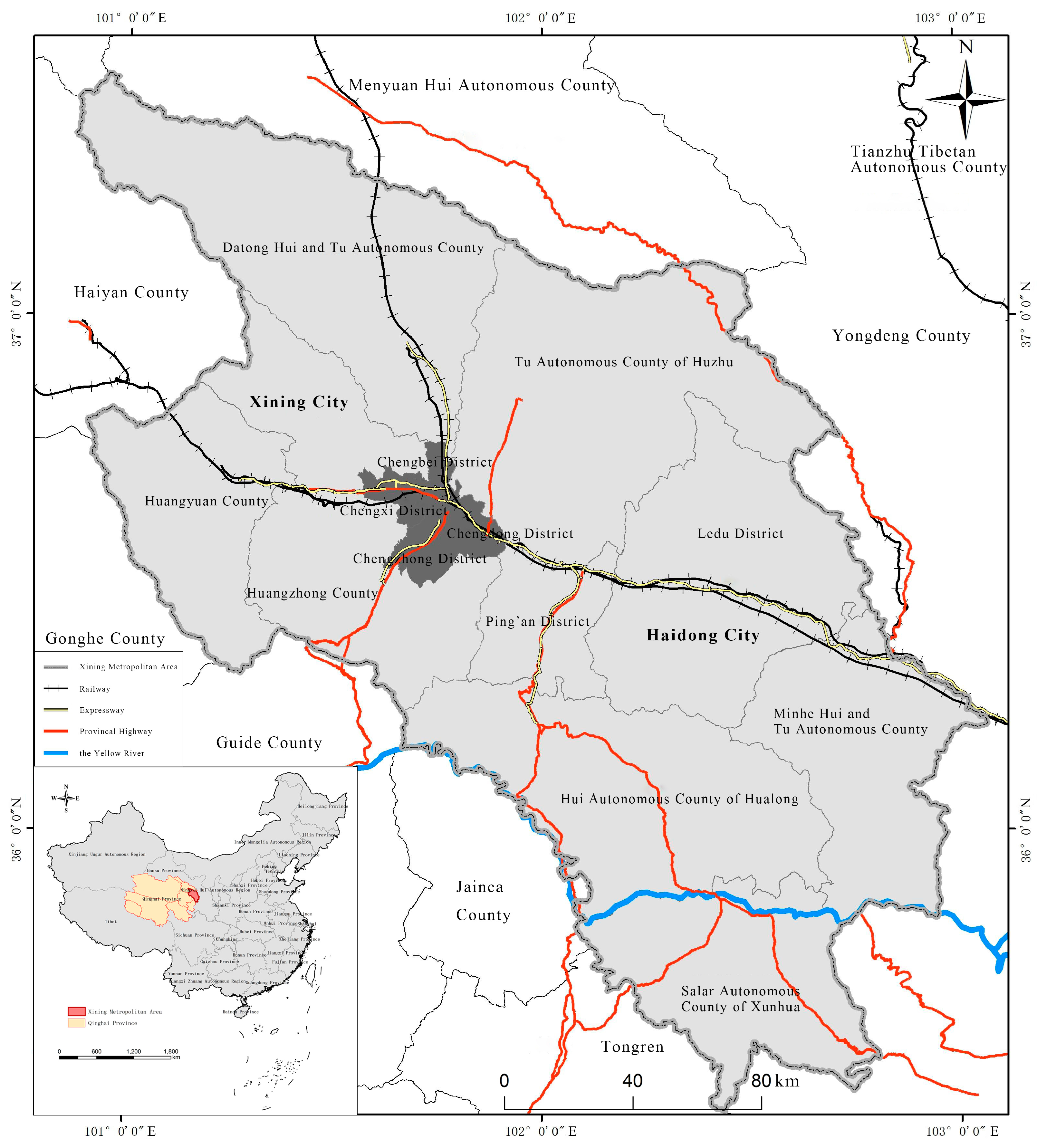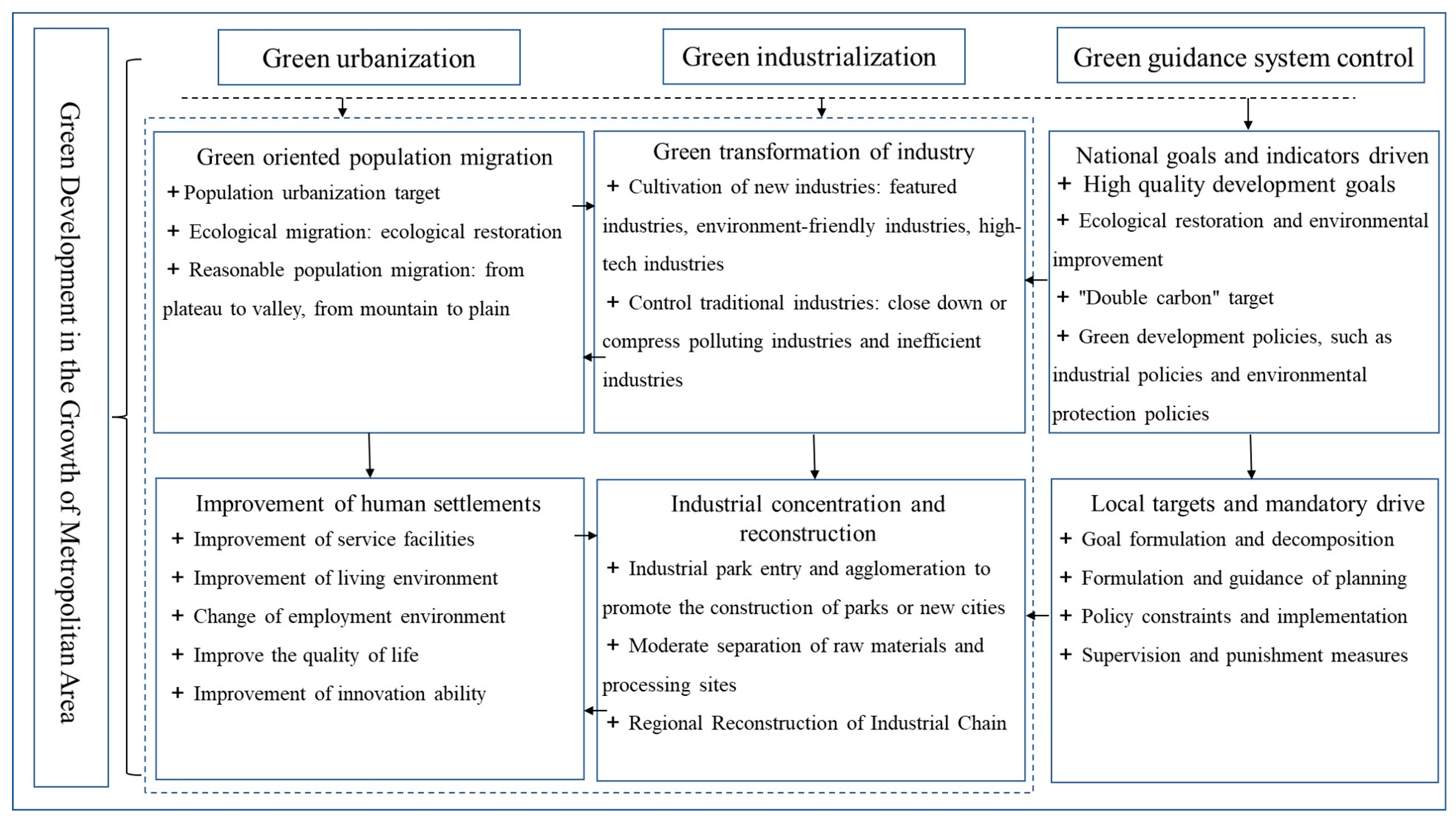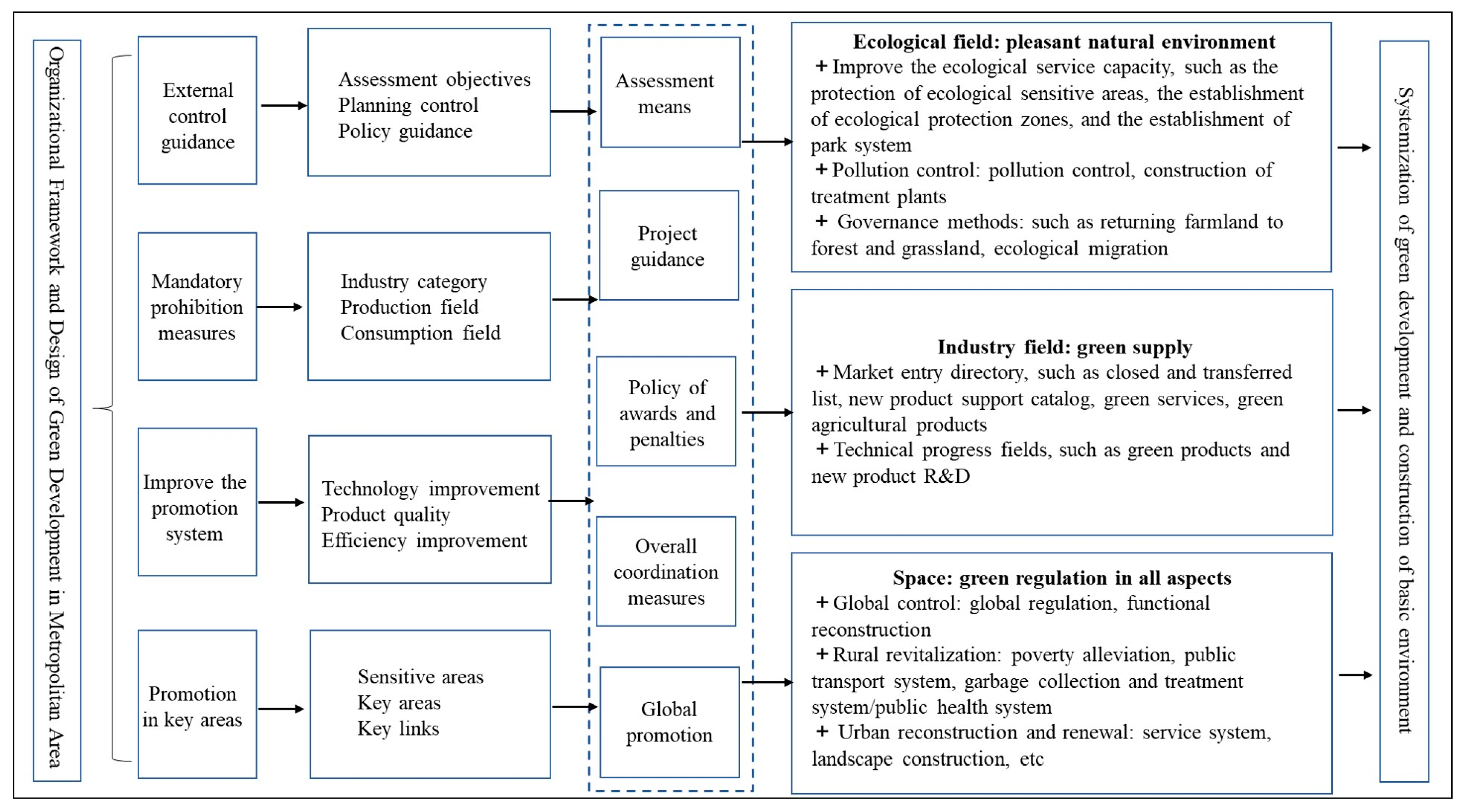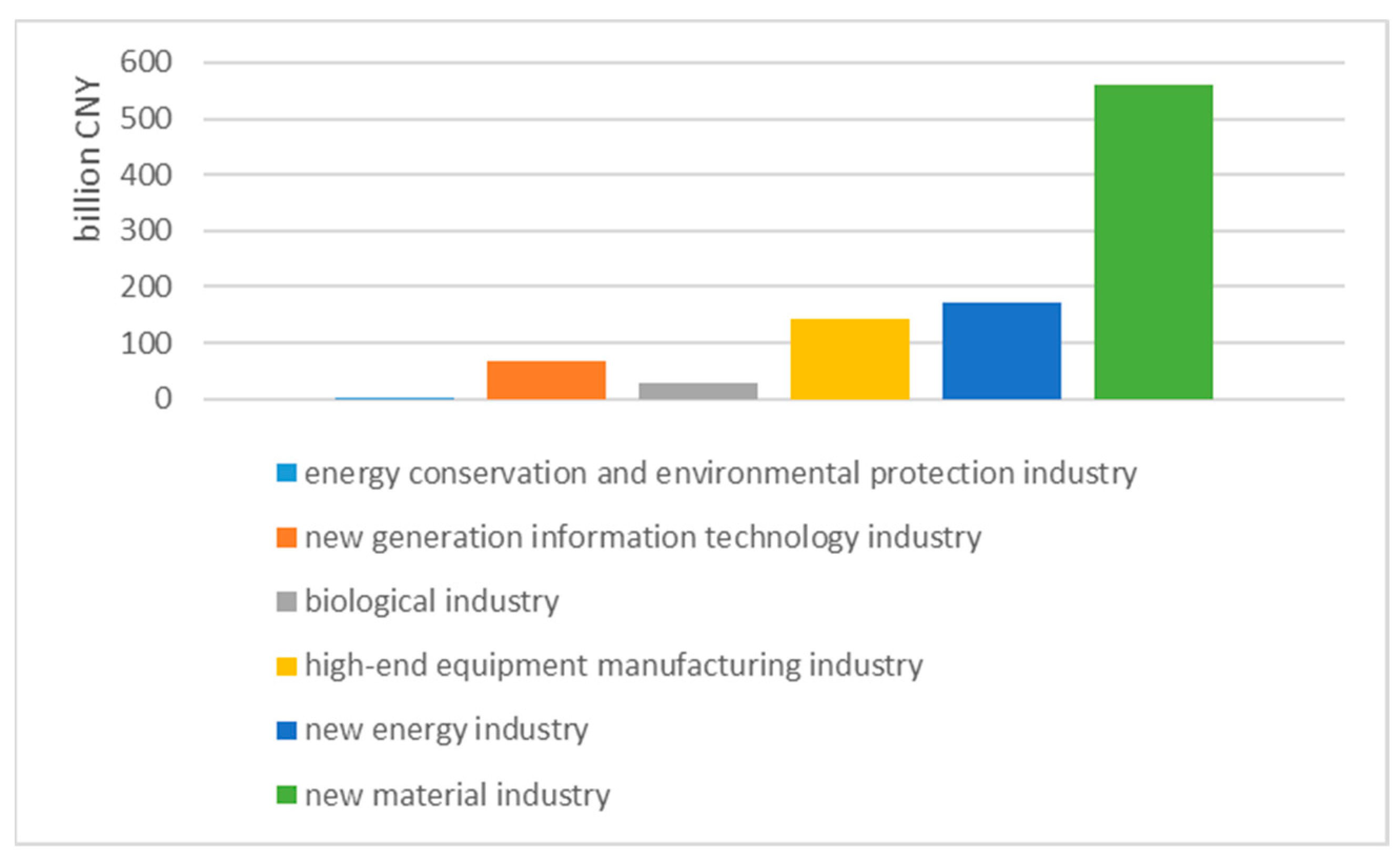A Systematic Government-Driven Green Development Transformation Strategy with Chinese Characteristics: The Case Study of the Xining Metropolitan Area
Abstract
1. Introduction
2. Materials and Methods
2.1. Research Area
2.2. Research Methods
3. The Systematic Drive of the Green Development Transformation of the XMA
3.1. Green Industrialization and Green Urbanization: A Mutually Reinforcing Two-Way Cycle
- (1)
- Industrial upgrading: “the transformation of new and old kinetic energy”. On the one hand, the old kinetic energy should be compressed as much as possible, according to the locality’s “own timetable“. That is, the governments at all levels have adopted a series of policies, such as “close up”, “out of the city and into the park”, “increasing the threshold of industrial entry” and “technical upgrading/renovation”, to continuously eliminate large-scale, high-energy-consuming, high-pollution and low-efficiency enterprises and compress “black” industries and “close up” enterprises with a poor efficiency so that the proportion of traditional energy, non-ferrous metals and mining industries continues to slowly decline. From 2016 to 2019, the energy consumption per unit of GDP of Xining decreased by 30.26%. Thus far, Haidong has basically eliminated the titanium alloy industry and dismantled the production equipment of silicon carbide. Traditional industries, such as the ferroalloy, cement and glass industries, are becoming further compressed or technologically upgraded. On the other hand, we should focus on “enhancing new kinetic energy”, that is, governments at all levels strive to promote the growth of new or advanced industries and reduce the consumption of, and negative impacts on, resources/the environment, such as knowledge-based and technology-based biology, medicine and new material industries. In the past 10 years, industries such as those producing lithium batteries, photovoltaics, biopharmaceuticals and optoelectronic components have developed rapidly in the XMA. Among them, the added value of high-tech industries in Xining accounts for 36.5%, and Xining possess the top ten lithium battery production lines in China. The “one district and four parks” in the Xining Economic and Technological Development Zone are rated as national green parks, and their seven small- and medium-sized enterprises are identified as national-level green enterprises. The total output value of the high-end green building materials in Ledu District Industrial Park reached CNY 678 million in 2018, accounting for approximately 75% of the total output value of the park. High-end equipment manufacturing and new material output accounted for approximately 20%.
- (2)
- Expanding the green industrial chain. The XMA should develop environmentally friendly and profitable industries such as characteristic industries, cultivate a whole green industrial chain and promote its regional integration. This process has strengthened or reshaped the connection between the raw material and processing areas of the industry and changed the spatial organization structure of related industries within the metropolitan area, such as those producing green agricultural and animal husbandry products and their deep processing products, including wolfberry, highland barley and yak with plateau characteristics. This has become a new direction for the green transformation of industries in the XMA.
- (1)
- Green-development-oriented population migration: Population migration and urbanization based on the concept of green development. As confirmed by face-to-face interviews, the population urbanization of the XMA has mainly manifested in three major characteristics: the population of Qinghai Province outside the metropolitan area have migrated to the interior of the area, while the population of the inner and outer districts and counties have migrated to the urban area and migrated from the urban areas within the metropolitan area to the main urban area of Xining. People have migrated from mountains and hills to river valleys due to factors such as migrant workers, high altitudes, poor living conditions and poverty alleviation policies [35,41], and the ecological environment of area of origin has been restored through the restoration of farmland to forests and grasslands. For example, the ecological environment of some plateau mountainous and hills is gradually improving due to natural restoration and human intervention restoration, because of the continuous decrease in the population size [42]. Combined with the rapid growth of industries and relevant policies, such as “going out of the city and entering parks”, the XMA has realized industrial spatial agglomeration, and its industrial spatial structure has been reshaped. A typical case of this process is the ecological migration pattern in which people are “forced to migrate because of poverty”. Ecological migration is a systematic state action that functions to eliminate poverty (classes), revitalize the countryside, restore ecology and increase (farmers’) income. The county/township governments in the XMA have relocated to towns or villages or been established in river valleys and plains through the method of “voluntary masses, self-financing by the people, and government investment”. The household registration and the land still belong to the villagers.
- (2)
- Green-oriented integration and improvement of urban and rural development. We must insist on urban system renewal, rural revitalization and the overall planning of urban and rural areas. On the one hand, the government achieves the purpose of systematically improving the living and production environment of residents through the construction of new urban areas/new cities and the renovation of old cities, such as the diversification, quality and high density of the Xining central area. With the joint efforts of the governments at all levels, in 2019, Xining implemented more than 15,000 sets of comprehensive renovation projects for old residential quarters in the cities and towns, while Haidong completed the comprehensive renovation of 2614 urban old residential quarters. On the other hand, the government promotes rural revitalization through the construction of beautiful villages. For example, Huangyuan County adheres to the overall planning and integrated promotion of urban and rural areas and continues to improve the urban and rural appearance and living environment.
3.2. “Top-Down” Green Development Drive: A Systematic Management and Control Model with Chinese Characteristics
- (1)
- Governments at all levels in the metropolitan area have enforced the control and governance of the ecological environment within their jurisdictions, which is also the “hard task” of the central government’s construction of the ecological civilization. This can be summarized as pollutant index control, the construction of treatment factories, integration of the rural environment into the treatment, ecological restoration and innovative system design. Almost all governments at all levels choose to start with the “source” of the pollution, with the following goals: first, to improve the management of binding indicators for energy conservation and emission reduction; second, to create a national water-saving city; third, to improve the economic system of green and low-carbon circular development, accelerate the circular reform of parks, improve the circular economy standards and certification systems, promote green reforms in key areas and key industries and promote circular links between production systems and living systems; and fourth, to build treatment facilities such as pollutant treatment plants, carry out the centralized treatment of pollutants, plan and build an industrial bases for the comprehensive utilization of industrial resources and build a waste resource recovery and recycling system that is integrated online and offline. At the institutional level, the city government has simultaneously performed innovation. Firstly, it has strengthened environmental regulations and the related supervision network, strengthened the prevention and control of pollution from mobile sources and improved the remote sensing monitoring network for motor vehicles. Among them, the environmental regulation of the metropolitan area presents a spatial differentiation of “high center and low edge”. For example, the highest environmental regulation area is concentrated in the main urban area of Xining City, with the greatest pressure regarding environmental improvement, while the peripheral counties and districts are relatively low, which shows that the efficiency of environmental regulation and economic development level creates the spatial coupling [43]. The government’s second aim is to fully implement and improve the “river and lake chief system”, actively promote the comprehensive management of rivers and improve the water quality of nationally controlled fault sections of the river basins. The third aim is to implement environmental protection and treatment projects and promote the joint prevention and control system in Xining and Haidong through, for example, the comprehensive treatment of various emission sources, such as industry, life, agriculture and natural dust. In fact, the various governments of the XMA have strengthened the risk prevention and control, treatment and restoration, and supervision of the development of polluted land and encouraged cross-regional cooperation to build hazardous waste treatment facilities [43,44]. This has yielded good results. For example, the proportion of days with good weather has greatly increased, and heavy pollution has basically been eliminated.
- (2)
- The metropolitan area focuses on the green guidance of the industry. Its core purpose is to improve the utilization rate of resources, cultivate green agriculture and the whole green industrial chain, improve the level of the service industry and reduce the discharge of pollutants according to the control indicators of the ecological environment. In practice, governments at all levels have accelerated the promotion of industrial green development guidance. The first goal is to basically form a circular-economy-oriented green industrial chain with local characteristics; to reduce the use of chemical fertilizers and pesticides and build a low-carbon ecological agriculture and agricultural and livestock product processing industry with the capacity for multi-level recycling (such as Haidong City’s initiative to ensure zero use of chemical fertilizers and pesticides and the active use of farm manure “pure” organic agricultural products in experimental areas); to improve the automation technology level of related industries and the construction of the entire industrial chain; and to integrate production, sales and services so as to expand the industrial chain and extend high-value-added industries (such as the highland barley wine storage business). The second is to create a circular economic system and form an ecological brand of the Qinghai–Tibet Plateau (such as organic fertilizers and plastic film recycling), expand the scale of the plateau’s characteristic industrial chain and drive the green transformation of the plateau’s internal planting industry, tourism development, and resource development in order to drive the formation of a regional spatial division of labor in the entire industrial chain. The third is to establish or develop the local branded industrial chain with the characteristics of the plateau, such as wolfberry and yak as the core, with the green industrial ecological economy characterized by the deep chemical industry of resource-based products, such as characteristic yak and highland barley. The fourth is to rapidly develop the high-tech industrial chain with the core of biology, medicine, lithium battery, etc., and to replace the traditional industries as far as possible.
- (3)
- Metropolitan areas attach importance to social services and technological progress, including a focus on service quality and social equity, the promotion of the introduction of technology and progress, and the promotion of green consumption and comprehensive benefits. The government has paid attention to the integration of local and internal scientific research forces, as well as the introduction, research and development, publicity, trading and brand building of serialized green agricultural products. By cultivating an ecological culture, the city government has increased the supply of green products and services, advocated a green, low-carbon lifestyle and advocated a simple, moderate, green and low-carbon lifestyle. At the same time, the city government has paid attention to the investment and introduction of technology to promote green development, especially in manufacturing, green agriculture and pollution control. For example, the city government has attempted to develop green agricultural products and organic agriculture by establishing agricultural industrial parks and other means. The green development of agriculture takes circularization, organization, specialization, chain extension and internalization as the basic paths to promote increases in farmers’ incomes, rural poverty alleviation and urban–rural integration. The city government “forcibly promotes” the production mode of agricultural products without chemical fertilizers, replacing chemical fertilizers with organic fertilizers, reducing agricultural pollution and actively building a green brand of organic agricultural products. On the other hand, agricultural development has also strengthened the integration of production–processing–sales and deep integration with the cultural tourism industry. For example, highland barley wine and other wine industries extend the industrial chain from agricultural product processing to form high-value-added industries, such as the Tianyoude Highland Barley Distillery, by attaching importance to cultural exhibitions and integration to form the unique culture of products and enterprises, establishing cultural exhibition halls in enterprises, and carrying out the wine storage businesses so that they complement each other through product sales. Thus, some enterprises have built new corporate spaces and formed their brand values and unique cultures. In addition, a few enterprises have set up highland barley and other planting bases outside the metropolitan area to regionalize the production chain. Therefore, the enterprises increase the added value of their products by paying attention to the combination of agriculture, animal husbandry, e-commerce and Internet+ and, especially, integrating e-commerce into agricultural development. The processing of branded agricultural products can be complemented with online promotion and online/offline sales. The enterprise can introduce the Industrial Internet into the slaughtering industry and combine it with the Internet APP to create an internet information platform for the slaughtering industry.
4. Actors and Basic Characteristics of the Green Development Transformation in the XMA
4.1. All levels of Government: Core Leaders, Facilitators and Monitors
4.2. Various Enterprises: Key Performers and Responders
4.3. Citizens and Media: Decentralized Doers and Receivers
5. Discussion
5.1. The Green Development Level of the XMA
5.2. The Socialist System with Chinese Characteristics Is the Institutional Guarantee for the Transformation of Green Development in Underdeveloped Areas
5.3. “Top-Down” Promotion and Differences between Actors
5.4. Systematic Green Development Still Requires Continuous External Support and Intra-Domain Collaboration
6. Conclusions
Author Contributions
Funding
Institutional Review Board Statement
Informed Consent Statement
Data Availability Statement
Conflicts of Interest
References
- Liu, W. Research Progress Overview of Green Innovation and Development at Home and Abroad. J. Hebei Univ. Environ. Eng. 2012, 22, 17–20. [Google Scholar]
- Rodrik, D. Green industrial policy. Oxf. Rev. Econ. Policy 2014, 30, 469–491. [Google Scholar] [CrossRef]
- Lütkenhorst, W.; Altenburg, T.; Pegels, A.; Vidican, G. Green Industrial Policy: Managing Transformation Under Uncertainty. Dtsch. Inst. Entwickl. Discuss. Pap. 2014, 28, 62. [Google Scholar]
- Rodrik, D.; Altenburg, T. Green Industrial Policy: Accelerating Structural Change towards Wealthy Green Economies; UN Environment: Geneva, Switzerland, 2017. [Google Scholar]
- Fay, M.; Hallegatte, S.; Vogt-Schilb, A. Green Industrial Policies: When and How (1 October 2013). World Bank Policy Research Working Paper No. 6677. Available online: https://ssrn.com/abstract=2346540 (accessed on 27 August 2022).
- Schwarzer, J. Industrial Policy for a Green Economy; International Institute for Sustainable Development: Winnipeg, MB, Canada, 2013. [Google Scholar]
- Gereffi, G.; Humphrey, J.; Sturgeon, T.J. The governance of Global Value Chains. Rev. Int. Political Econ. 2005, 12, 78–104. [Google Scholar] [CrossRef]
- Gereffi, G.; Lee, J. Economic and social upgrading in global value chains and industrial clusters: Why governance matters. J. Bus. Ethics 2016, 133, 25–38. [Google Scholar] [CrossRef]
- Colin, F.; Peter, J.T.; Liu, Y. Political Geography: World Economy, Nation State and Power; The Commercial Press: Beijing, China, 2016. [Google Scholar]
- Pearce, D.; Markandya, A.; Barbier, E. Blueprint for a Green Economy: A Report; Earthscan Publications Ltd.: London, UK, 1989. [Google Scholar]
- Liu, S. Green Economy Theory: Economic Development Theory Reform and China’s Economic Reengineering; Chinese Financial & Economic Publishing House: Beijing, China, 2001. [Google Scholar]
- Hu, A. China: Innovative Green Development; China Renmin University Press: Beijing, China, 2012. [Google Scholar]
- Lin, B.; Benjamin, N.I. Green development determinants in China: A non-radial quantile outlook. J. Clean. Prod. 2017, 162, 764–775. [Google Scholar] [CrossRef]
- Liu, X.; Zhang, S. Chinese Enterprise Green Transition: Target Pattern, Obstacles and Countermeasures. China Popul. Resour. Environ. 2015, 25, 724. [Google Scholar] [CrossRef]
- Choi, Y.; Bone, C.; Zhang, N. Sustainable policies and strategies in Asia: Challenges for green growth. Technol. Forecast. Soc. Chang. 2016, 112, 134–137. [Google Scholar] [CrossRef]
- Huang, J.; Lv, H.; Wang, L. Mechanism of financial development influencing regional green development: Based on eco-efficiency and spatial econometrics. J. Geogr. Res. 2014, 3, 532–545. [Google Scholar] [CrossRef]
- Gu, C. Research on Urban and Regional Planning: Planning Reform and Coordinated Development; The Commercial Press: Beijing, China, 2015. [Google Scholar]
- Zheng, D.; Zang, Z.; Sun, C.; Li, H. Prediction and analysis of the transition to green economy in China based on the theory of ecosystem services. Acta Ecol. Sin. 2014, 34, 7137–7147. [Google Scholar]
- Li, X.; Hu, B. China: Green Economy and Sustainable Development; People’s Publishing House: Shanghai, China, 2012. [Google Scholar]
- Shi, Y. Research on the mechanism and system of green economy development in China. Times Financ. 2015, 22, 17–18. [Google Scholar]
- Lan, Q.; Han, J. Study on the green transformation strategy of China’s industry. Reform Econ. Syst. 2012, 30, 24–28. [Google Scholar]
- Yang, X. China’s green economy transformation development and strategy response under the new normal. J. Party Sch. Fuzhou 2015, 21, 72–76. [Google Scholar]
- Yang, C.; Liljelund, L. Research on the Development Mechanism and Policy Innovation of China’s Green Economy; China Environmental Press: Beijing, China, 2012. [Google Scholar]
- Yang, Y.; Meng, Q.; McCarn, C.; Cooke, W.; Rodgers, J.; Shi, K. Effects of path dependencies and lock-ins on urban spatial restructuring in China: A historical perspective on government’s role in Lanzhou since 1978. Cities 2016, 56, 24–34. [Google Scholar] [CrossRef]
- Liu, Z.; Yang, Y. The Urban Environmental Quality Assessment of the Valley-Cities in the Western China. J. Arid. Land Resour. Environ. 2005, 3, 10–16. [Google Scholar]
- Yang, Y.; Liu, Z. The Changing Trend and Mechanism of Water Pollution of Valley city in the West of China during Recent 30 Years. J. Mt. Res. 2006, 1, 33–53. [Google Scholar]
- Yang, Y.; Liu, Z. The Changing Trend of Solid Waste Pollution of Valley-city in West China during Recent 20 Years. J. Arid. Land Resour. Environ. 2007, 12, 47–56. [Google Scholar]
- Yang, Y. Study on the Basic Contradictions and Mechanisms of Environment Pollution in the Valley-cities in West China. J. Arid. Zone Res. 2006, 2, 364–374. [Google Scholar]
- Liu, J.; Shao, Q.; Fan, J.; Deng, X. Exploration on the Path of Ecological Protection and Construction in Western China. J. China Popul. Resour. Environ. 2013, 23, 38–43. [Google Scholar]
- Zhang, J.; Zou, J.; Wu, Q.; Chen, X. Onthe Spatial Organization of the Metropolitan Area. J. City Plan. Rev. 2001, 5, 19–23. [Google Scholar]
- Zhang, C.; Yang, Y. Concept Analysis of Metropolitan Coordinating Region. J. City Plan. Rev. 2007, 4, 31–36+47. [Google Scholar]
- Vigorously Promote the Construction of Xining Haidong Metropolitan Area. Available online: http://www.iud.ecnu.edu.cn/6b/42/c15031a224066/page.htm (accessed on 5 September 2022).
- Zhang, X.; Chai, Y. Influencing factors of residents’ commuting behavior in Xining: A SEM analysis using activity-travel diary survey data. J. Geogr. Res. 2018, 11, 2331–2343. [Google Scholar]
- Yang, Y.; Jia, Z.; Zhang, Y.; Chang, G. New-Type Urbanization and Green Development Transformation of Xining Metropolitan Area; Lanzhou University Press: Lanzhou, China, 2023. [Google Scholar]
- Yang, Y.; Zhao, M.; Jia, Z.; Cheng, S. Study on green development planning of plateau Xining metropolitan area. Areal Res. Dev. 2022, 41, 56–62. [Google Scholar]
- Tang, Y.; Yang, Y.; Cheng, S. Corporate perspective: Investment sources and influencing factors in the development zone of Xining City, China. J. Lanzhou Univ. (Nat. Sci.) 2020, 5, 615–622. [Google Scholar]
- Man, S.; Yang, Y.; Zeng, T.; Liu, Q. Spatial structure and influencing factors of cross-border urban networks in the western China. Sci. Geogr. Sin. 2021, 4, 674–683. [Google Scholar]
- Fang, C. The Scientific Basis and Systematic Framework of the Optimization of Chinese Urban Development Pattern. J. Econ. Geogr. 2013, 12, 1–9. [Google Scholar]
- Yin, Z.; Yuan, X.; Lu, Q.; Lin, P.; Wang, Q. China Metropolitan Area Development Report 2018; Tsinghua University Press: Beijing, China, 2018. [Google Scholar]
- Wang, B. Research on regional differences and dynamic mechanism of new urbanization. Stat. Decis. 2020, 36, 77–82. [Google Scholar]
- Zhou, Q. Spatial Patterns of Human Settlements in Northern Shanxi; China Architecture & Building Press: Beijing, China, 2009. [Google Scholar]
- Li, L. Research on new Patten Urbanization in Agricultural and Pastoral Areas of Qinghai Province. Master’s Thesis, Yunnan University of Finance and Economics, Kunming, China, 2020. [Google Scholar]
- Jia, Z.; Yang, Y.; Zhao, J.; Chen, X. Spatial pattern and spatial convergence of environmental regulation efficiency of Lanzhou-Xining urban agglomeration in the Yellow River Basin. J. Sci. Geogr. Sin. 2022, 42, 568–578. [Google Scholar]
- Jia, Z.; Yang, Y.; Zhao, J.; Chen, X. Prediction and analysis of the transition to green economy in China based on the theory of ecosystem services. J. Geogr. Res. 2021, 40, 2897–2913. [Google Scholar]
- Chen, H. Industrial Upgrading and Regional Structure Remodeling of Metropolitan Area; Science Press: Beijing, China, 2018. [Google Scholar]







Disclaimer/Publisher’s Note: The statements, opinions and data contained in all publications are solely those of the individual author(s) and contributor(s) and not of MDPI and/or the editor(s). MDPI and/or the editor(s) disclaim responsibility for any injury to people or property resulting from any ideas, methods, instructions or products referred to in the content. |
© 2023 by the authors. Licensee MDPI, Basel, Switzerland. This article is an open access article distributed under the terms and conditions of the Creative Commons Attribution (CC BY) license (https://creativecommons.org/licenses/by/4.0/).
Share and Cite
Xu, J.; Yang, Y.; Jia, Z.; Chang, G.; Zhang, Y.; Zhao, M.; Wang, W. A Systematic Government-Driven Green Development Transformation Strategy with Chinese Characteristics: The Case Study of the Xining Metropolitan Area. Int. J. Environ. Res. Public Health 2023, 20, 1321. https://doi.org/10.3390/ijerph20021321
Xu J, Yang Y, Jia Z, Chang G, Zhang Y, Zhao M, Wang W. A Systematic Government-Driven Green Development Transformation Strategy with Chinese Characteristics: The Case Study of the Xining Metropolitan Area. International Journal of Environmental Research and Public Health. 2023; 20(2):1321. https://doi.org/10.3390/ijerph20021321
Chicago/Turabian StyleXu, Jing, Yongchun Yang, Zhuo Jia, Genying Chang, Yongjiao Zhang, Maoyuan Zhao, and Wenrui Wang. 2023. "A Systematic Government-Driven Green Development Transformation Strategy with Chinese Characteristics: The Case Study of the Xining Metropolitan Area" International Journal of Environmental Research and Public Health 20, no. 2: 1321. https://doi.org/10.3390/ijerph20021321
APA StyleXu, J., Yang, Y., Jia, Z., Chang, G., Zhang, Y., Zhao, M., & Wang, W. (2023). A Systematic Government-Driven Green Development Transformation Strategy with Chinese Characteristics: The Case Study of the Xining Metropolitan Area. International Journal of Environmental Research and Public Health, 20(2), 1321. https://doi.org/10.3390/ijerph20021321





